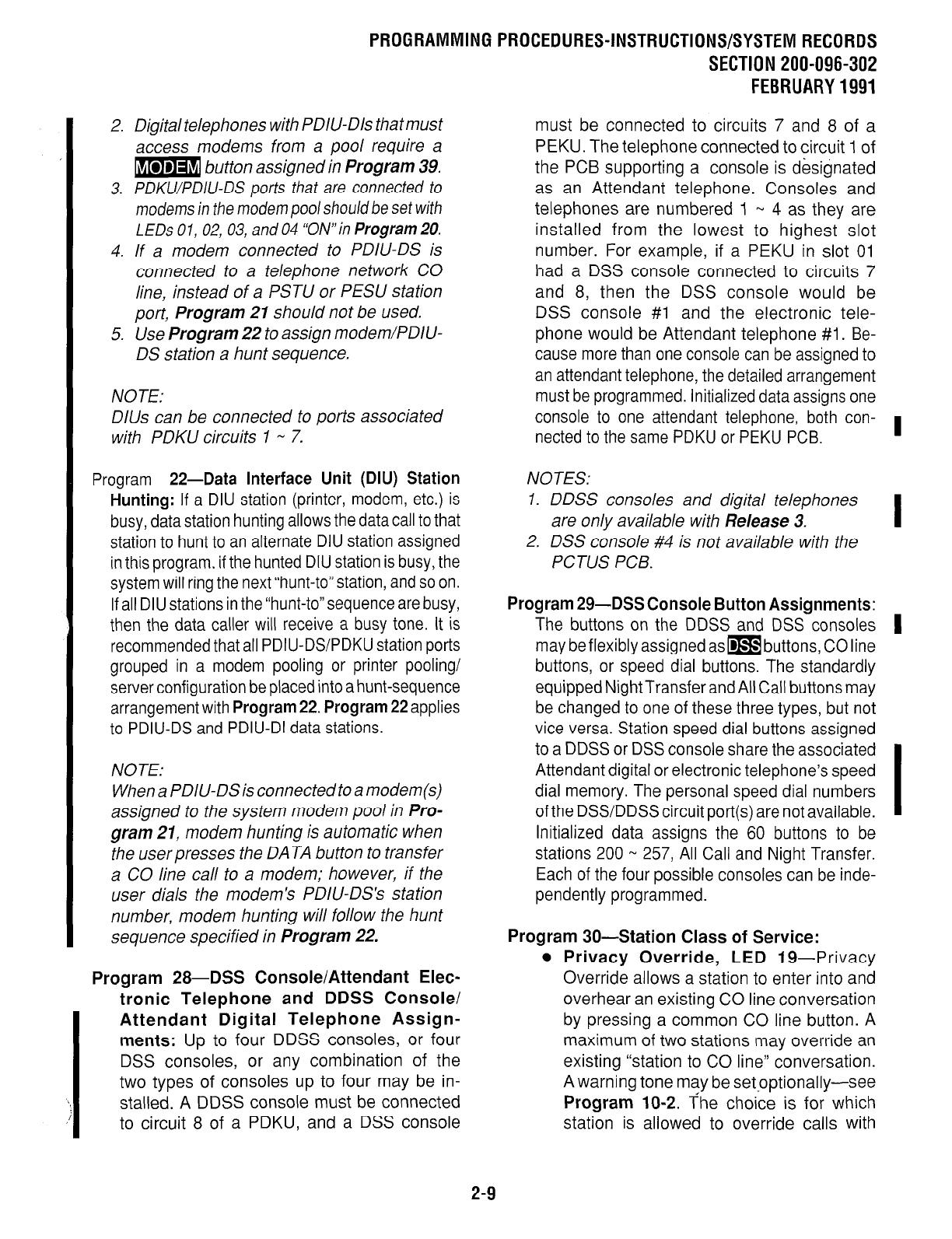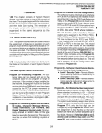
PROGRAMMINGPROCEDURES-INSTRUCTIONSKXTEMRECORDS
SiCTlON 200-096-302
FEBRUARY1991
2. Digitaltelephones with PDIU-Dls thatmusi
access modems from a pool require a
m button assigned in
Program 39.
3. PDKU/PDIlJ-DS ports that are connected to
modems in the modern pool should be set with
LEDs 01, 02, 03, and
04
“0N”in
Program 20.
4. If a modem connected to PDIU-DS is
connected to a telephone network CO
line, instead of a PSTU or PESU station
port,
Program 21
should not be used.
5.
Use
Program
22 to assign modem/PDIU-
DS station a hunt sequence.
NOTE:
DlUs can be connected to ports associated
with PDKU circuits 1 - 7.
Program
22-Data Interface Unit (DIU) Station
Hunting:
If a DIU station (printer, modem, etc.) is
busy, data station hunting allows the data call to that
station to hunt to an alternate DIU station assigned
in this program. if the hunted DIU station is busy, the
system will ring the next “hunt-to” station, and so on.
If all DIU stations in the “hunt-to”sequence are busy,
then the data caller will receive a busy tone. It is
recommended that all PDIU-DSPDKU station ports
grouped in a modem pooling or printer pooling/
server configuration be placed into a hunt-sequence
arrangement with
Program 22. Program
22 applies
to PDIU-DS and PDIU-DI data stations.
NOTE:
When a PDIU-DSis connected to a modem(s)
assigned to the system modem pool in
Pro-
gram
21, modem hunting is automatic when
the user presses the DATA button to transfer
a CO line call to a modem; however, if the
user dials the modem’s PDIU-DS’s station
number, modem hunting will follow the hunt
sequence specified in
Program 22.
Program 28-DSS Console/Attendant Elec-
tronic Telephone and DDSS Console/
Attendant Digital Telephone Assign-
ments:
Up to four DDSS consoles, or four
DSS consoles, or any combination of the
two types of consoles up to four may be in-
stalled. A DDSS console must be connected
to circuit 8 of a PDKU, and a DSS console
must be connected to circuits 7 and 8 of a
PEKU. The telephone connected to circuit 1 of
the PCB supporting a console is designated
as an Attendant telephone. Consoles and
telephones are numbered 1 w 4 as they are
installed from the lowest to highest slot
number. For example, if a PEKU in slot 01
had a DSS console connected to circuits 7
and 8, then the DSS console would be
DSS console #I and the electronic tele-
phone would be Attendant telephone #I. Be-
cause more than one console can be assigned to
an attendant telephone, the detailed arrangement
must be programmed. Initialized data assigns one
console to one attendant telephone, both con-
nected to the same PDKU or PEKU PCB.
NOTES:
1. DDSS consoles and digital telephones
are only available with
Release 3.
2. DSS console #4 is not available with the
PCTUS PCB.
Program 29-DSS Console Button Assignments:
The buttons on the DDSS and DSS consoles
may be flexibly assigned asmbuttons, CO line
buttons, or speed dial buttons. The standardly
equipped Night Transfer and All Call buttons may
be changed to one of these three types, but not
vice versa. Station speed dial buttons assigned
to a DDSS or DSS console share the associated
Attendant digital or electronic telephone’s speed
dial memory. The personal speed dial numbers
of the DSSDDSS circuit port(s) are not available.
Initialized data assigns the 60 buttons to be
stations 200 N 257, All Call and Night Transfer.
Each of the four possible consoles can be inde-
pendently programmed.
Program 30-Station Class of Service:
l
Privacy Override, LED
19-Privacy
Override allows a station to enter into and
overhear an existing CO line conversation
by pressing a common CO line button. A
maximum of two stations may override an
existing “station to CO line” conversation.
A warning tone may be setpptionally-see
Program 10-2.
The choice is for which
station is allowed to override calls with
2-9


















